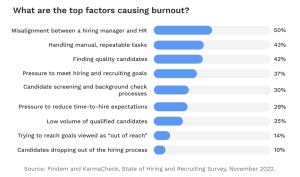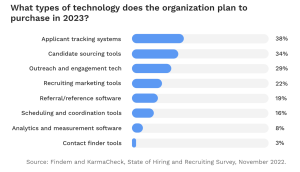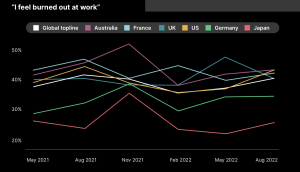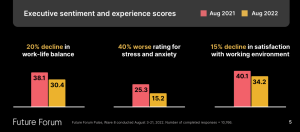With six in ten US workers admitting they experience at least moderate levels of burnout – a figure that is up by 52% compared to the previous 12 months – it’s little wonder HR professionals have a lot on their plates right now.
But, as is often the case with professionals whose job is to look after others, their own self-care is often found lacking.
So is it time HR professionals actually starting recognizing (and then tackling) their own dangerously-high levels of burnout too?
New research published last month suggests they really ought to.
In just one area of their responsibly – recruitment – new data reveals pressure to meet their own targets is causing 61% of HR leaders to consider quitting their roles altogether.
The finding comes from the State of Hiring & Recruiting study from KarmaCheck, which studied more than 300 HR leaders at large U.S. employers. It found that most are consistently failing to hit their goals, causing them to miss key hires and adding to their stress.
Hiring is biggest source of stress for HRDs
Of all the tasks HR is responsible for, it seems hiring is single biggest source of stress for HRDs. KarmaCheck finds that 54% of HR leaders polled say they’ve previously quit a prior job precisely because of hiring and recruiting stress.
The data reveals that more than half (51%) say they’re missing their cost-per-hire target (shown to be the most-tracked metric), while 47% are not meeting goals around average time to fill roles and 42% are failing to get candidates through the hiring process on time.

It observes that these unmet goals, combined with inefficient processes and the volatile hiring market are all driving high levels of burnout – posing serious problems for HR teams and organizations as a whole. Seventy-three percent report experiencing recruiting and hiring burnout and, of that group, a 51% majority deal with signs of burnout regularly with 22% saying their burnout is near daily. As a result, nearly two-thirds have considered quitting in the past year.
“There’s a perfect storm brewing, with HR leaders telling us they’re missing key hires, missing critical cost-per-hire goals and losing team members left and right to burnout,” says Hari Kolam, CEO of talent acquisition company, Findem.He added: “Those that do take quick action will be well positioned for takeoff as the economy rebounds.”
As Mai Ton, chief people officer at Ethic, wrote in Time magazine last summer: “In my 20 years as a human-resources leader, I’ve seen a lot: heated debates where chairs were slung across marble conference tables; a lunch where two partners almost came to blows and I, at a mere 5 feet tall, had to stand in between them.” She added: “But this is nothing compared to what I’ve been witnessing in these last two years. HR teams have been tasked with the impossible job of seeing the future; they’ve been de facto therapists; they’ve been in-house nurses; and now many of them simply have no energy left.”
According to KarmaCheck, challenges facing HR professionals have been particularly acute in the healthcare, tech and financial services sectors. Healthcare HR leaders were the most likely to cite hiring goal pressures as a source of their burnout–54% in healthcare versus 34% across other industries studied.
More HRDs are burnt out
This isn’t the first time the plight of HRD’s own levels of stress/burnout has been raised. Last year, a study by Workvivo amongst 520 HR professionals in the US and UK showed a shocking 98% (yes 98%) said they felt burned out. Drilling down deeper, 97% admitted they felt ‘emotionally drained’ with work; 94% said they felt ‘overwhelmed’ while 88% actually ‘dreaded’ work.
What’s striking about both these statistics is not just the level of burnout HR officers say they now experience, but also the suggestion that that HR leaders feel they are largely being left to shoulder these macro workplace issues on their own. The Workvivo report found that only 29% of HR professionals said they felt their work was valued within the organization.
C-suite support (or lack of it), is also compounded by HR professionals saying they don’t have the tools they need to actually do their jobs properly.
Workvivo found 73% of HR professionals reported this, while KarmaCheck’s data found 37% of those polled said they were still using inefficient hiring processes while 16% said they needed better automation technology.
Only one-third (32%) of HR and recruiting leaders blame candidate pools not being a fit as the main reason they are not reaching their goals, and even fewer (12%) blame staffing shortages. Instead, a majority (56%) blame process inefficiency or technology challenges as the main reasons they fail to meet key metrics.
Perhaps more significantly than this, of the HR respondents who’d previously quit their job due to hiring stress, 95% said they would have likely stayed there if their employer had provided more or higher-quality technology.
The bad news is that investment in better technology seems not to be a priority. Just 38% of HRDs polled by KarmaChec said their employer would be investing in applicant tracking systems in 2023. It was even lower for candidate sourcing tools (34%); recruitment marketing tools (22%) and analytics and measurement software (8%).

So where does this leave HRDs – those who are clearly struggling to do what they can with the resources they have, but which are unlikely to be able to add to this them year?
The reality is that they are probably not in a very good place – for the time being at least.
The first thing HRDs must do is spot their own first signs of burnout – whether it’s increased frustration or indifference towards work; increased irritability; being withdrawn, exhausted or demonstrating reduced effectiveness in their role.
HRDs are notoriously bad at taking time off. Research from Qualtrics and HR Brew found that in 2021, only half of HR professionals took their allotted PTO.
But what then?
Well, we think the best tonic is always to hear what other people are doing.
So, TLNT wants to hear from you!
What are you doing to reduce your own levels of burnout?
What tips can you share with your fellow HR professionals.
Email TLNT at peter@ere.net, and we’ll publish the best replies in a future article.
The rise (and rise) of manager burnout
A recent survey from Future Forum found burnout is on the rise globally, most significantly in the US where 43% of middle managers reported burnout – more than any other worker group.
The rise of burnout – globally and the US

- The percentage of employees who say they are burned out rose 8% among the global workforce (from 37% to 40%) between May and August.
- The rise was even more pronounced among US workers, rising 16% between May and August from 37% to 43%.
- US workers now show the highest incidence of burnout globally with more than two out of every five U.S. workers saying they are burned out.

